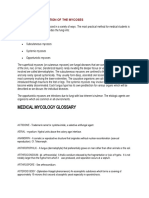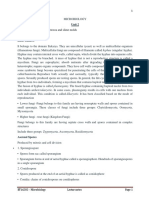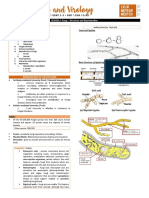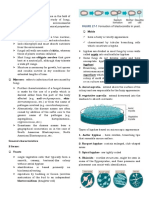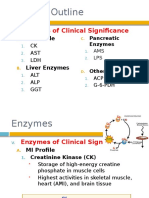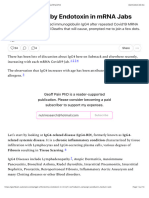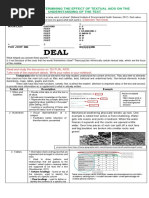0 ratings0% found this document useful (0 votes)
154 viewsFungi
Fungi
Uploaded by
Ria AlcantaraFungi constitute a diverse group of organisms that are generally classified as molds or yeasts. They have several distinguishing characteristics including being eukaryotic, having cell walls containing chitin, and requiring a host. Fungi can reproduce both sexually through teleomorphs and asexually through anamorphs and conidia. They are classified into four main divisions - Zygomycota, Ascomycota, Basidiomycota, and Deuteromycota. Identification is based on characteristics such as hyphal structure, pigmentation, and reproductive structures. Many fungal genera are opportunistic pathogens in immunocompromised individuals.
Copyright:
© All Rights Reserved
Available Formats
Download as DOCX, PDF, TXT or read online from Scribd
Fungi
Fungi
Uploaded by
Ria Alcantara0 ratings0% found this document useful (0 votes)
154 views2 pagesFungi constitute a diverse group of organisms that are generally classified as molds or yeasts. They have several distinguishing characteristics including being eukaryotic, having cell walls containing chitin, and requiring a host. Fungi can reproduce both sexually through teleomorphs and asexually through anamorphs and conidia. They are classified into four main divisions - Zygomycota, Ascomycota, Basidiomycota, and Deuteromycota. Identification is based on characteristics such as hyphal structure, pigmentation, and reproductive structures. Many fungal genera are opportunistic pathogens in immunocompromised individuals.
Original Description:
Fungi
Copyright
© © All Rights Reserved
Available Formats
DOCX, PDF, TXT or read online from Scribd
Share this document
Did you find this document useful?
Is this content inappropriate?
Fungi constitute a diverse group of organisms that are generally classified as molds or yeasts. They have several distinguishing characteristics including being eukaryotic, having cell walls containing chitin, and requiring a host. Fungi can reproduce both sexually through teleomorphs and asexually through anamorphs and conidia. They are classified into four main divisions - Zygomycota, Ascomycota, Basidiomycota, and Deuteromycota. Identification is based on characteristics such as hyphal structure, pigmentation, and reproductive structures. Many fungal genera are opportunistic pathogens in immunocompromised individuals.
Copyright:
© All Rights Reserved
Available Formats
Download as DOCX, PDF, TXT or read online from Scribd
Download as docx, pdf, or txt
0 ratings0% found this document useful (0 votes)
154 views2 pagesFungi
Fungi
Uploaded by
Ria AlcantaraFungi constitute a diverse group of organisms that are generally classified as molds or yeasts. They have several distinguishing characteristics including being eukaryotic, having cell walls containing chitin, and requiring a host. Fungi can reproduce both sexually through teleomorphs and asexually through anamorphs and conidia. They are classified into four main divisions - Zygomycota, Ascomycota, Basidiomycota, and Deuteromycota. Identification is based on characteristics such as hyphal structure, pigmentation, and reproductive structures. Many fungal genera are opportunistic pathogens in immunocompromised individuals.
Copyright:
© All Rights Reserved
Available Formats
Download as DOCX, PDF, TXT or read online from Scribd
Download as docx, pdf, or txt
You are on page 1of 2
Fungi constitute an extremely diverse group of
organisms and are generally classified as either
molds or yeasts.
General Characteristics
Fungi:
Mitochondria, Eukaryotic, Nuclear Membrane,
True Nucleus, Cell Wall Chitin (must need a host)
Bacteria:
Prokaryotic
Plants:
Chlorophyll, Cell Wall Cellulose (doesnt need a
host)
Fungi:
- obligate aerobes with neutral ph 7.0 (although
can tolerate wide range of ph
- Moisture is necessary for growth
- spores and conidia survive in dry conditions
Yeast:
- single vegetative cells
-form smooth, creamy, bacterial like-colony
- without aerial hyphae
- both micro and macroscopic are similar
- identification of yeast is based on biochemical
testing
- produce by budding with production of
blastoconidium (daughter cell)
- process involves lysis of the yeast cell wall to
form blastoconidium
- as structure enlarges, nucleus is passed into
blastoconidium, a septum forms and
blastoconidium breaks free.
Moulds:
- fuzzy or woolly appearance because of mycelia
- mycelia are made up of many log strands of
tube-like structures called hyphae. (either aerial
or vegetative)
- Mycelia support reproductive structures that
produce conidia
- conidia can be used to identify different fungal
genera
- Aerial mycelia extends above surface of
colony and responsible for fuzzy or woolly
appearance
- Vegetative mycelia extends downward to
absorb nutrients from the medium (media)
- The microscopic appearance often aids in
identification of moulds
Types of hyphae:
Spiral hyphae are tightly coiled spirals
Antler hyphae have swollen branching tips that
resemble moose antlers.
Racquet hyphae have enlarged, club-shaped
areas
Rhizoids hyphae are root like structures, might
see in some Zygomycetes, and their presence
and placement can assist with identification.
Fungal hyphae are described or referred as
septate or sparsely septate.
septate hyphae show frequent cross-walls
occurring perpendicularly to outer walls of the
hyphae
sparsely septate hyphae have few cross-walls
at irregular.
aseptate hyphae meaning absence of
septations, has historically been used to describe
the hyphae of Zygomycetes.
Microscopic examination of hyphae associated
with Zygomycetes often reveals occasional
septations; therefore these hyphae are correctly
termed sparsely septate as opposed to
aseptate.
HYALINE (MONILIACEOUS) VS.
DEMATIACEOUS:
- pigmentation is useful in identification
- Hyaline ormoniliaceous hyphae are either
nonpigmented or lightly pigmented.
- Dematiaceous hyphae are darkly
pigmented because of melanin in the cell wall.
- It depends on the amount of melanin
present; the hyphae will appear pale to dark
brown or nearly black. The dark hypha seen
in tissue section is dark-colored because of
stains that enable better visualization of
fungal elements in tissue and not melanin.
Stain used: Gomori methylene stain = fungal
elements appears black.
Fontana-Masonstain = stains melanin causing
dematiaceous hyphae appear brown whereas
hyaline hyphae remain pink to red (another
stain used in hyphal pigmentation in tissues)
DIMORPHISM VS. POLYMORPHISM:
Dimorphism refers to the ability of some fungi
to exist in 2 forms depending on growth
conditions.
- Dimorphic fungi include a mould phase and
either a yeast or spherule phase.
- Yeast, spherule or tissue state is seen in
vivo or when the organism is grown 37 C w/
increased CO2.
- Mould phase is seen when the organisms
grown at room temperature (22-25 C) in ambient
air conditions.
- Thermally dimorphic fungal species
associated w/ human disease include:
Blastomycesdermatitidis,
Coccidioidesimmitis,
Histoplasmacapsulatum var. capsulatum,
Paracoccidioidesbrasiliensis,
Sporothrixschenckii,
andPenicilliummarneffei.
- mycoses = infections due to fungi
- Polymorphic fungi have both yeast and
mould forms in the same culture. This
characteristic occurs despite growth conditions
and is best observed in Exophiala spp. where
yeast phase is observed initially followed by
mould phase as colony ages.
REPRODUCTION
Fungi can reproduce either asexually (imperfect)
or sexually (perfect).
- Asexual reproduction results in formation of
conidia (singular:conidium) following mitosis.
- It is carried out by specialized fruiting structures
known as conidiogenous cells.
- conidiogenous cellsform conidia which contains
all genetic material necessary to create a new
fungal colony.
- Two common conidiogenous cells are the
phialide which are vase like structures that
produce phialoconidia and the annelideare
ringed structures that produce anneloconidia.
Both form their conidia blastically (budding) like
many yeasts: the parent cell enlarges and
septum forms to separate the conidial
cell.Another is arthroconidia which formed by
fragmentation of fertile hyphae.
- In clinical laboratory, most mould identification
is based on the structures formed as a result of
asexual reproduction.
- Sexual reproduction requires the joining of
two compatible nuclei followed by meiosis.
Teleomorph fungus that reproduce sexually but
ocassionally will reproduce asexually and this
asexual form is termed anamorph.
- Synanamorphs if more than one anamorph is
present for the same teleomorph.
The best example phenomenon is the
teleomorphPseudallescheriaboydii, which has
two anamorphs: Scedosporiumapiospermum
and Graphium sp. These two anamorphs are
synanamorphs to each other.
TAXONOMY:
Most of the etiologic agents of clinical infections
are found in four groups of fungi. They consist
of the divisions Zygomycota, Ascomycota,
Basidiomycota, and form-division Fungi
Imperfecti (Deuteromycota).
ZYGOMYCOTA
Members of class Zygomycetes
rapidly growing organisms
found in soil
opportunistic pathogens in immunocompromised
hosts.
gray to white, aerial mycelium
sparsely septate hyphae
asexual reproduction of Zygomycetes is
characterized by the presence of
sporangiophoresand sporangiospores.
The asexual spores (sporangiospores) are
produced in structure called sporangium which
develops from a sporangiophore.
Some zygomycetes are capable of sexual
reproduction resulting in the production of
zygospores.
- Common Zygomycetes are Mucor, Rhizopus,
and Absidia
ASCOMYCOTA
- production of sexual spores known as
ascospores.
- formed within saclike structure known as ascus.
- identified on the basis of characteristic asexual
structures.
- Microsporum spp. Trichopytonsppand
Pseudallescheriaboydii(teleomorph)
BASIDIOMYCOTA
- are few and the only known major pathogen is
Filobasidiellaneoformans perfect form of
Cryptococcus neoformans var. neoformans.
- Basidiomycetous moulds recovered in
laboratory remain sterile, complicating the
identification process.
- presence of clamp connection is one clue if a
mould is basidiomycete.
Clamp connection occur at the septations in
the vegetative hyphae and easily visible with
light microscopy.
- portion of hypha on one side of the septations
grows out and connects to hypha on the other
side of septations, bypassing the septation.
- Basidiomycetous moulds are being recovered in
increasing numbers in laboratory, but their role in
infectious disease is not understood.
FUNGI IMPERFECTI or DEUTEROMYCOTA
- contains the largest number of organisms that
are etiologic agents of mycoses, including
cutaneous, subcutaneous, and systemic disease.
- Organisms with no mode of sexual
reproductionhave been identified,
-identified on the basis of characteristic asexual
reproductive structures.
You might also like
- The Complete Hematopathology GuideDocument113 pagesThe Complete Hematopathology GuideJenny SNo ratings yet
- Gut Feelings - The Emerging Biology of Gut-Brain Communication, Emeran A. MayerDocument15 pagesGut Feelings - The Emerging Biology of Gut-Brain Communication, Emeran A. Mayeraltemio100% (1)
- Intro To Mycology Prelims2Document47 pagesIntro To Mycology Prelims2Annika Abad100% (1)
- Replication, Transcription, Translation and Its Regulation: By, University of Agricultural Sciences, DharwadDocument42 pagesReplication, Transcription, Translation and Its Regulation: By, University of Agricultural Sciences, DharwadTabada NickyNo ratings yet
- Ap Bio The Real SpidermanDocument12 pagesAp Bio The Real Spidermanapi-460281036No ratings yet
- Case StudyDocument7 pagesCase StudyBilly Belando50% (2)
- MBC 305 Pat 1and 2Document19 pagesMBC 305 Pat 1and 2Usman SurajNo ratings yet
- 1 - Mycology-Chapter-OneDocument70 pages1 - Mycology-Chapter-OneMimo HemadNo ratings yet
- SaprophytesDocument40 pagesSaprophytesRami Aldalistar100% (1)
- Lec1 Fungal Taxonomy Dr. Hamzia AliDocument7 pagesLec1 Fungal Taxonomy Dr. Hamzia AliBenson ShayoNo ratings yet
- MoldsDocument10 pagesMoldsvyoma agarwalNo ratings yet
- Fungi IntroductionDocument23 pagesFungi Introductionalhaitham alqmeNo ratings yet
- Medical Mycology Glossary: Clinical Classification of The MycosesDocument6 pagesMedical Mycology Glossary: Clinical Classification of The MycosesrheyanNo ratings yet
- Mycology Intro NotesDocument7 pagesMycology Intro NotesDarwin CruzNo ratings yet
- SMB3103Document147 pagesSMB3103xasantalan3No ratings yet
- Microbiology - FungiDocument31 pagesMicrobiology - FungiAnnisa NisaNo ratings yet
- FungiDocument15 pagesFungisukikiwaNo ratings yet
- LectureonFungi_Part1Document22 pagesLectureonFungi_Part1Cheska CuyaNo ratings yet
- KINGDOM FUNGIDocument7 pagesKINGDOM FUNGIBachaspatimayum Sunanda SharmaNo ratings yet
- Molds YeastDocument8 pagesMolds YeastAnandNo ratings yet
- Mycology Lecture 1, 2 and 3Document183 pagesMycology Lecture 1, 2 and 3Aikens Kwaku Smog NewtonNo ratings yet
- Mycology Lecture 1, 2 and 3-1Document200 pagesMycology Lecture 1, 2 and 3-1Aikens Kwaku Smog NewtonNo ratings yet
- Kingdom FungusDocument51 pagesKingdom FungusujjayantsNo ratings yet
- CLASS 11 Biological Classification Part 2 Kingdom Fungi To Lichens.Document11 pagesCLASS 11 Biological Classification Part 2 Kingdom Fungi To Lichens.Rozita PraveenNo ratings yet
- Lecture 1 FungiDocument23 pagesLecture 1 FungiDragon Gie30No ratings yet
- ParawordDocument4 pagesParawordCHRISTIAN HOWARD SAGUBAYNo ratings yet
- Mycv Lec FinalsDocument124 pagesMycv Lec FinalsRiel VillaminNo ratings yet
- Basic Mycology: Russell G. Panem, RMT School of Medical Technology Chinese General Hospital CollegesDocument47 pagesBasic Mycology: Russell G. Panem, RMT School of Medical Technology Chinese General Hospital CollegesJaellah MatawaNo ratings yet
- Lecture 3: Fungi, Algae, Protozoa and Slime Molds: Unit 2Document21 pagesLecture 3: Fungi, Algae, Protozoa and Slime Molds: Unit 2Nivashini VindhyaNo ratings yet
- Introduction To Fungi and Terminology2021Document117 pagesIntroduction To Fungi and Terminology2021Yasmeen Atieh1No ratings yet
- Maseno University School of Public Health and Community Development Department of Public Health PHT 222:medical MicrobiologyDocument29 pagesMaseno University School of Public Health and Community Development Department of Public Health PHT 222:medical MicrobiologyOld LakeNo ratings yet
- (Microbiology and Parasitology) Basic and Clinical MycologyDocument43 pages(Microbiology and Parasitology) Basic and Clinical MycologyMa. Pia Lorein JacintoNo ratings yet
- Introduction in Myco ViroDocument46 pagesIntroduction in Myco ViroMariann EstoqueNo ratings yet
- Fungal Classification, Structure, and ReplicationDocument23 pagesFungal Classification, Structure, and ReplicationDoc RomeoNo ratings yet
- FUNGI - 6-Sem112Document42 pagesFUNGI - 6-Sem112menNo ratings yet
- BIO 102 by DR Keshinro OMDocument32 pagesBIO 102 by DR Keshinro OMfaborodeharyomideNo ratings yet
- Group 2 Written ReportDocument12 pagesGroup 2 Written ReportReynisa 딸기우유No ratings yet
- Structure and Reproduction of FungiDocument5 pagesStructure and Reproduction of FungiJiyahnBayNo ratings yet
- Fungi: Prepared by Elina Shrestha M.SC - MM Pokhara UniversityDocument45 pagesFungi: Prepared by Elina Shrestha M.SC - MM Pokhara UniversityElena ShresthaNo ratings yet
- Ch45 Med Mycology 2017-2Document248 pagesCh45 Med Mycology 2017-2YugmaPandyaNo ratings yet
- ALE Review MycologyDocument44 pagesALE Review MycologyJayson BasiagNo ratings yet
- Pharmaceutical Microbiology Unit 3Document45 pagesPharmaceutical Microbiology Unit 3Karan PathakNo ratings yet
- AscomycetesDocument16 pagesAscomycetesKyle Chadee100% (1)
- Done Introduction To MycologyDocument6 pagesDone Introduction To MycologytdisnahNo ratings yet
- Fungi: by Wella Afriani 1111012041Document34 pagesFungi: by Wella Afriani 1111012041wella afrianiNo ratings yet
- Myco NotesDocument36 pagesMyco NotesJoan ClaveNo ratings yet
- FUNGIDocument3 pagesFUNGIDevanand DongreNo ratings yet
- Intro To MycologyDocument8 pagesIntro To Mycologycamille chuaNo ratings yet
- Fungi PDFDocument64 pagesFungi PDFSilvia Tri ayu100% (1)
- DaseqwDocument57 pagesDaseqwChiNo ratings yet
- General MycologyDocument72 pagesGeneral Mycologyashishchoudhary4204No ratings yet
- An Introduction To Medical Mycology: Definition of FungiDocument14 pagesAn Introduction To Medical Mycology: Definition of FungidocaisaNo ratings yet
- Medical MycologyDocument62 pagesMedical MycologyWai Kwong ChiuNo ratings yet
- Ilovepdf Merged 1Document193 pagesIlovepdf Merged 1Angelica RatonNo ratings yet
- Intro To MycoDocument6 pagesIntro To Mycojohn hector regpalaNo ratings yet
- Bota 131 - General Microbiology - Lesson Four - 2024 - Dr. Ogolla-1Document9 pagesBota 131 - General Microbiology - Lesson Four - 2024 - Dr. Ogolla-1zakayomacdonald294No ratings yet
- Mrs. S.Vaidehi Assistant Professor D.G.Vaishnav CollegeDocument22 pagesMrs. S.Vaidehi Assistant Professor D.G.Vaishnav CollegeSrinivasa RaghavanNo ratings yet
- DownloadDocument30 pagesDownloaddaikseemeeNo ratings yet
- المحاضرة الحادية عشرةDocument24 pagesالمحاضرة الحادية عشرةشمس.No ratings yet
- Medical Mycology: Reymel B. Magora, RMTDocument39 pagesMedical Mycology: Reymel B. Magora, RMThanny jammyNo ratings yet
- C11 16-Aug-2016 Bit1007 EthDocument12 pagesC11 16-Aug-2016 Bit1007 EthsantoshNo ratings yet
- Bio English Fungi Made Ayu Malina Dewi 1913041005Document7 pagesBio English Fungi Made Ayu Malina Dewi 1913041005Ayu MalinaNo ratings yet
- Mushroom Spotter's Deck: A Field Guide to Fungi & Their Age-Old WisdomFrom EverandMushroom Spotter's Deck: A Field Guide to Fungi & Their Age-Old WisdomNo ratings yet
- Microbiology: a QuickStudy Laminated 6-Page Reference GuideFrom EverandMicrobiology: a QuickStudy Laminated 6-Page Reference GuideRating: 5 out of 5 stars5/5 (1)
- EnzymesDocument60 pagesEnzymesRia Alcantara100% (1)
- Renal FunctionDocument6 pagesRenal FunctionRia AlcantaraNo ratings yet
- MycoViro 2Document44 pagesMycoViro 2Ria Alcantara100% (2)
- BunyaviridaeDocument12 pagesBunyaviridaeRia AlcantaraNo ratings yet
- Mycology NotesDocument106 pagesMycology NotesRia Alcantara100% (2)
- SpermogramDocument286 pagesSpermogramalmutazimNo ratings yet
- Genetic EngineeringDocument17 pagesGenetic EngineeringDALEY ZISSNo ratings yet
- 2020 6 3 136 145 EngDocument10 pages2020 6 3 136 145 EngRevanthNo ratings yet
- Memo For Exam May June 2010 BLG1502Document4 pagesMemo For Exam May June 2010 BLG1502Leigh MakanNo ratings yet
- Daniel Liu (2027) - Disease Detectives Food Born Illnesses Cheat SheetDocument2 pagesDaniel Liu (2027) - Disease Detectives Food Born Illnesses Cheat Sheetst44seNo ratings yet
- LabReportNew - 2023-06-23T171149.608Document1 pageLabReportNew - 2023-06-23T171149.608B AZAD SIMHANo ratings yet
- Grade 9 Slk-Non-Mendelian-Week-4Document17 pagesGrade 9 Slk-Non-Mendelian-Week-4MilagrosBautistaNo ratings yet
- Term 2 Revision (2) (2151)Document11 pagesTerm 2 Revision (2) (2151)mahiraNo ratings yet
- Kualitas Perairan Tambak Udang Berdasar Parameter MikrobiologiDocument14 pagesKualitas Perairan Tambak Udang Berdasar Parameter MikrobiologirurikaimudinNo ratings yet
- Marsilio Et Al., 2023Document23 pagesMarsilio Et Al., 2023Charmila SouzaNo ratings yet
- IgG4 Affected by Endotoxin in mRNA Jabs - by GeoffPainPhDDocument14 pagesIgG4 Affected by Endotoxin in mRNA Jabs - by GeoffPainPhDbrunolacroix953100% (1)
- MSPN Guide To MM Investigations FINALDocument32 pagesMSPN Guide To MM Investigations FINALJuliana FurbringerNo ratings yet
- Gram Positive Cocci (GPC) Gram Neg (Rods GNR) Anaerobes Atypicals Classification AntibioticDocument2 pagesGram Positive Cocci (GPC) Gram Neg (Rods GNR) Anaerobes Atypicals Classification AntibioticRami RaedNo ratings yet
- Week 2 Notes and TaskDocument4 pagesWeek 2 Notes and TaskJames Patrick De LeonNo ratings yet
- Chapter Test ADocument5 pagesChapter Test Asat.study.51No ratings yet
- Multiple Organ Dysfunction SyndromeDocument21 pagesMultiple Organ Dysfunction SyndromeRo-Anne LozadaNo ratings yet
- PEROXISOMALDocument22 pagesPEROXISOMALIZAAZ BFNo ratings yet
- Doctors in Training 2012 Step 1Document473 pagesDoctors in Training 2012 Step 1André LassanceNo ratings yet
- Molecular Basis of Inheritance PYQS Ans Key - 19189643 - 2023 - 06 - 05 - 12 - 38Document25 pagesMolecular Basis of Inheritance PYQS Ans Key - 19189643 - 2023 - 06 - 05 - 12 - 38Arsh DhawanNo ratings yet
- Week 2 LaboratoryDocument21 pagesWeek 2 Laboratorykimmynemil80No ratings yet
- Clinical Radiobiology - Previous Examination Papers Updated 270709Document20 pagesClinical Radiobiology - Previous Examination Papers Updated 270709Arthi Elango100% (1)
- Acute Hepatitis: Dr.G.Indhumathi MD.Document39 pagesAcute Hepatitis: Dr.G.Indhumathi MD.Parthiban AnnaduraiNo ratings yet
- Actinidia Deliciosa (Kiwi Fruit) : A Comprehensive Review On TheDocument10 pagesActinidia Deliciosa (Kiwi Fruit) : A Comprehensive Review On TheAlberto ParraNo ratings yet
- The Role of Hyaluronic Acid and Versican in The Skin Extracellular MatrixDocument16 pagesThe Role of Hyaluronic Acid and Versican in The Skin Extracellular MatrixTara KamaranNo ratings yet
- Flashcards - Topic 6.7 Response To Infection - Edexcel (B) Biology A-Level PDFDocument37 pagesFlashcards - Topic 6.7 Response To Infection - Edexcel (B) Biology A-Level PDFPrasanthanNo ratings yet
- Sts MidtermsDocument10 pagesSts MidtermsEla Mae CoNo ratings yet












